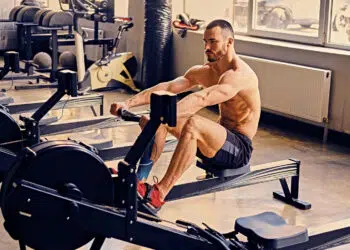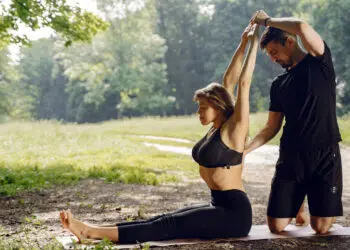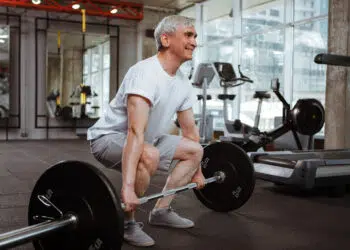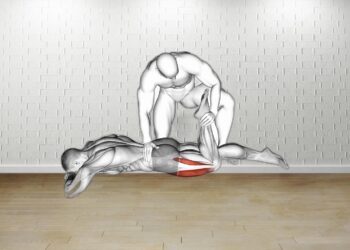As hard as it may be to imagine your sexy toosh as anything more than an eye magnet, the muscles in your rear end are vitally important to every form of lower body movement. Capable glutes allow you to lift heavy weights, maximize your athletic efforts, walk with good posture, and move the legs in various directions.
“The areas critical for mobility are in your lower extremities: your calves, your hamstrings, your hip flexors in the pelvis, and quadriceps in the front of the thigh,” explained David Nolan, a physical therapist at Harvard affiliated Massachusetts General Hospital.
In other words, it’s more important to stretch some muscles than others, especially one like the king gluteus maximus, the largest and strongest muscle group that nature equipped our backsides with. The lying glute stretch, or figure four technique utilizes your own two legs to create eccentric tension and elongate the major muscles in your glutes and hips.
I tested this stretch and came up with what I like about it and why it’s different than the other variations. In short, it combines lying down, opening the hip and pulling the leg which allows you to get a deeper stretch, emphasize the inner glute, and control movement and direction of your leg.
Check out my full lying glute stretch guide below, where I also threw in some other amazing butt stretching techniques. First let’s learn the glute stretch and then we’ll tell you why you should do it.
How To Do The Lying Glute Stretch
The lying glute stretch requires a standard level of flexibility, and most people can do it even if they hardly stretch. However, for some, it may be more challenging if you lack hip mobility or have a history of knee issues. Before you attempt or get too deep in the lying glute stretch, determine if you can do it comfortably.
Level Up Your Fitness: Join our 💪 strong community in Fitness Volt Newsletter. Get daily inspiration, expert-backed workouts, nutrition tips, the latest in strength sports, and the support you need to reach your goals. Subscribe for free!
We included a short video instructional and written steps below.
Steps
- Lie back on a soft surface like an exercise mat, carpet, etc with your knees bent and feet flat on the floor.
- Place your right foot and ankle overtop your left thigh.
- Then lift your feet up, and grab the back of your left leg with both hands by interlocking the fingers against the hamstring muscles.
- Gently pull your left leg back toward your head until you feel the stretch in your right butt muscles.
- Hold for 5-10 seconds, take a short rest, then repeat two to three more times.
- Switch legs and complete the same number of sets for the other side.
Pro tip: The closer your foot is to the inside of your thigh, the more you should feel the stretch on the inner part of your glutes.
Check out a quick demonstration of the lying glute stretch via the following video tutorial.
Muscles Used During Lying Glute Stretch
The lying glute stretch is the definition of a true, authentic isolation exercise because if done right, you’ll feel it only in the butt and nowhere else. While everyone knows where their heinie is, they don’t have a clue about its purpose, or even that your butt is more than one muscle. Although somehow they know squats make them bigger and stronger.
So we’ll help you out with a mini anatomy lesson so you can be better acquainted with your derrière.
Glutes
Your rump is a combination of four muscles, the gluteus maximus, medius, and minimus, as well as tensor fasciae latae (TFL), which is also part of the gluteal group. Although the gluteus maximus dominates both in size, strength, and weight. In fact, it’s the largest muscle that you have.
The three “glute” named muscles, but primarily the maximus head forms what actually looks like the “butt” while, TFL muscle gives shape to the outer hip.
So what do the glutes do?
Well, your fanny (I can come up with these all day) is mainly in charge of straightening the legs at the hip (Rising from a squat), and moving the leg away from the body. However, they can also help pull the leg inward, and rotate the thigh both in and out. A regular stretching routine can help maintain flexibility and movement in these vital muscles.
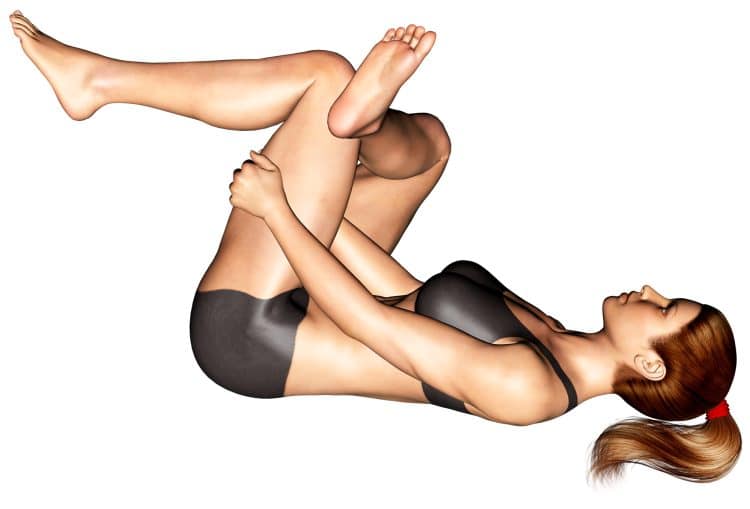
Benefits
We’ll hit you with some truth about the benefits of stretching your glute muscles, and why you should be incorporating a few minutes of stretching every week.
Have more control over the stretch
Some variations are less flexible (No pun intended) when it comes to adjusting your position. However, with the lying glute stretch, you have more control of the legs both due to the position, and using your arms as the controller.
Be limitation-free
Everyone knows that stretching makes you more flexible. But not everyone realizes the consequences of never doing it. If you weren’t aware, when muscles contract they move the bones to flex and extend the joints. Hence tight, shortened muscles decrease a joint’s range of motion. Although the synovial fluid in your joints is also important for range of motion, but assuming this isn’t the issue for the purpose of this guide (1).
Well, this not only affects your movement, but it sets you up for injuries when too much pressure is applied to the body part during an activity, and the muscle lacks the pliability to make the movement safely possible. Tight glutes disrupt everything from your lower back to the hamstrings and knees, and can become a real problem.
So while weights and aerobics are awesome, don’t ignore regular, weekly stretching sessions.
Run, jump, play, and lift to your potential
Being such a large and downright powerful muscle, your glutes, and especially your lovely maximus plays an otherworldy role in your ability to not only generate hulk-like explosiveness, but show the world “America’s Ass” (Avengers reference).
A bottom that can stretch into a deep squat, is one that will take care of all your athletic and physical needs, while optimizing your rear end development too.
Level Up Your Fitness: Join our 💪 strong community in Fitness Volt Newsletter. Get daily inspiration, expert-backed workouts, nutrition tips, the latest in strength sports, and the support you need to reach your goals. Subscribe for free!
In fact, a 2020 study found that using a full range of motion resulted in more benefits partial movements during lower body resistance training (2). So having a willing pair of glutes will only benefit your gains!
Avoid broken bones
Falls and injuries are easier to recover from during youth, and for several decades after. But once you start entering older ages where things aren’t as resilient, you need to be especially careful. Believe it or not, tight glutes can cause falls due to functional imbalances as the muscles and surrounding material lack optimal elasticity to bend with your efforts.
The effects are twofold as your joint’s motion is limited while the fascia over and between the muscles suffer from maladaptation to normal movements and activities.
Common Mistakes
The lying glute stretch is hard to mess up. It’s straightforward and you should feel an immediate stretch in the target muscles. Here are some technique tips and things to avoid to both protect yourself and get an incredible glute stretch.
Twisting up your knees
The key to a safe and effective lying glute stretch is to keep your legs stationary, and move them as a single unit. Don’t pull your leg and push the opposite knee forward as you can jack up your knees this way. Keep the bent leg in one position, and let it move back as you pull the other leg toward you.
Stressing your back
One thing you don’t need to do is crunches while performing the lying glute stretch. It’s not an ab activity. Lie flat on your back, relax yourself, and pull to deepen the stretch.
Variations and Alternatives
After testing out each variation below, it doesn’t get better than these options for zoning right in on that perfect glute stretch.
Closed hip lying glute stretch
After you’re done with the lying glute stretch, stay in that position with one leg crossed over the other. You’re going to now grab the top of your opposite leg with both hands, and pull it toward your opposite shoulder. You’ll find that it’s much easier, as your arms don’t have to reach as far, and you’ll feel a much deeper stretch, especially in the outer hip as you can pull the leg closer to your body.
By doing this, you close the hip, unlike the lying glute stretch which forces it to stay open. As a result, I believe both are useful variations that emphasize different aspects of the lower posterior. It’s pretty simple and there’s not a whole to explain.
Simply pull down on the lifted leg cross your body gently until you’re satisifed with the stretch.
Seated glute stretch
This one feels amazing too, I like having an alternative to lying down, but that’s not standing either. It should feel similar to the other variations (Right in the buttocks) but while also relieving the lower back of any tension.
To do it:
- Sit on the floor with your legs straight out in front of you and spread wide.
- Now bend the left leg and pull the foot in toward your groin like if you were doing a butterfly stretch.
- Then bend the right leg, and hook it on the outside of your left leg.
- Hug your right leg and pull it into your stretch to produce the glute stretch.
- Hold for several seconds, then switch legs, repeat, and continue alternating until you’ve stretched each side two to three times.
90-90 glute stretch
The double ninety represents each leg as both are bent at 90-degree angles to create an optimal stretching pose. The leg angles create the ideal degree of tension, and then you can lean in and stretch to your heart’s content.
The 90-90 may not be ideal for those with knee problems so keep this in mind and don’t force yourself into a painful position.
To do it:
- Sit on the floor with your legs straight out in front of you.
- Then bend one leg in front and one behind both at 90-degrees angles.
- Keeping your back straight, bend forward to facilitate the stretch and gradually increase your range of motion to enhance the feeling.
- Hold for 5-10 seconds, sit up, reset then back at it again and repeat two more times on this side before switching your legs to the other side.
Make sure to switch legs and alternate for an equal number of rounds per side.
Seated figure four
The most discreet of them all, you could perform this stretch at your work desk in the office, at church, or anywhere you can plant your butt down in a seat. This one is great if you don’t want to get down on the floor and it’s how many of us sit anyway.
Seated figure four emphasizes the stretch in your piriformis muscle, which slips through the butt and wraps around to the top of the thigh, where it assists in lower body actions.
To do it:
- Sit at the edge of any seat where you can keep both feet flat on the floor.
- Lift your right foot and place it on top of the left thigh in a gentlemen’s sitting pose.
- Gently press down onto the right knee and slowly lean your upper body forward to accentuate the stretch in your buttocks.
- Then you can rest and repeat a few more times, and make sure to switch legs to target the other side afterwards.
Here’s a brief clip showing this seated stretch.
FAQ’s
How often should I perform the lying glute stretch?
If you’ve determined that you have tight glutes and it’s affecting your daily living, you may need to get on a more strenuous stretching regime. But if you can generally move around, and perform activities without pain or limited movement, less is needed. However, we still recommend stretching a minimum three days per week for two to three rounds.
My glutes are really tight and affecting my day to day activities, what should I do?
Ideally, if possible, and if you’re not able to pinpoint the root cause of persistent tightness in your glutes, we recommend seeking a professional diagnosis from a qualified health professional who can help diagnose and remedy chronically tight glutes muscles.
They may prescribe a more advanced stretching routine for you, such as proprioceptive neuromuscular facilitation (PNF) stretching, a method that expedites the process by pushing your muscles hard, causing the body to activate a protective reflex that prevents overstretching (1).
Who should not do the lying glute stretch?
If you have bad knees or hips, the lying glute stretch could be difficult or painful. You’ll need to determine if you have adequate flexibility and healthy enough joints to perform this stretch safely an comfortably.
Wrapping Up
The lying glute stretch is a sure fire way to ward off potential physical limitations of tight posterior hips. Being the largest human muscle that delivers the highest force per contraction to answer our constant demands, we keep asking yet give so little back.
Whether you’re super active, work from your butt, or are getting up there in age, stretching is one of the core good habits to maintain body health. Don’t wait until you’re thrown out of alignment or suffer an injury or pulled muscles to start doing more of it.
So if you’re going to start stretching anything, the central complex separating your upper and lower body is a really good place to start.
References:
- Page P. Current concepts in muscle stretching for exercise and rehabilitation. Int J Sports Phys Ther. 2012 Feb;7(1):109-19. PMID: 22319684; PMCID: PMC3273886.
- Schoenfeld BJ, Grgic J. Effects of range of motion on muscle development during resistance training interventions: A systematic review. SAGE Open Med. 2020 Jan 21;8:2050312120901559. doi: 10.1177/2050312120901559. PMID: 32030125; PMCID: PMC6977096.



